As an Amazon Associate I earn from qualifying purchases. Click for details.
Bonito City and its ghosts – if there are any – were featured in a 2009 ghost-related TV show.
The show’s three ghost enthusiasts visited Bonito Lake in Lincoln County, New Mexico. However, that show’s version of Bonito City’s past was very different from actual history. They may have missed the real ghosts of Lincoln County.
Martin Nelson and Bonito City, New Mexico
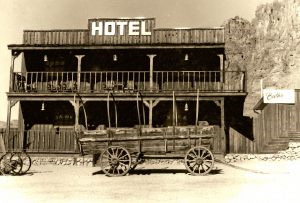 According to TV shows…
According to TV shows…
Bonito City was a thriving town until the night Martin Nelson shot and killed seven innocent people at the Mayberry Hotel for no apparent reason. After that tragedy, people began to move away. It’s as if Martin Nelson killed the town, not just some of its citizens.
Some years later, a dam was built that flooded the ghost town – and all of its buildings – to create Bonito Lake. Soon, people reported ghosts at the lake, including the dangerous spirit of Martin Nelson. Today, people avoid the site and whatever haunts beneath its waters.
The Truth about Bonito City
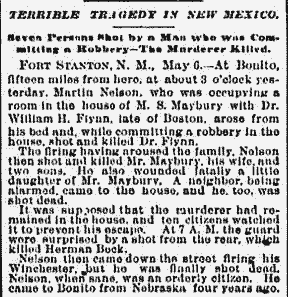 Bonito City was one of many western towns that sprung up briefly when people were looking for gold.
Bonito City was one of many western towns that sprung up briefly when people were looking for gold.
Martin Nelson came to Bonito City to strike it rich as a miner, but soon realized that there wasn’t much gold. He could do better with petty crime… and so he did.
One night, Martin Nelson was interrupted while robbing the hotel room of Dr. William H. Flynn who had recently arrived from Boston.
After a loud fight over the watch that Nelson planned to steal, Nelson shot everyone who stood between him and a quick escape… including the doctor, five members of the family that owned the hotel, and two neighbors.
Then, Nelson was shot and killed by Charlie Barry, the local Justice of the Peace.
In the years that followed, people gradually moved away from the town. Mining near Bonito City required hard work for few results. A few people stayed to farm, but most figured they could do better elsewhere.
By the early 20th century, Bonito City was a ghost town and conveniently located near the Rio Bonito… an ideal water source for the Southern Pacific Railroad.
After negotiating with the remaining landowners, the railroad began building a dam to store water in the newly-created Bonito Lake.
However, since they needed clean water, every building, sidewalk and fence in Bonito was torn down and removed before the city was flooded. The graves were also moved to nearby Angus, New Mexico.
Today, Bonito Lake is a favorite vacation spot for campers, mountain bikers, fishermen, and rock hounds.
HERE’S THE COMPLETE STORY…
More Details – Bonito City and Gold Fever
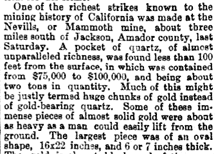 When gold was discovered in California, many people dreamed of becoming rich overnight. All an area had to do was hint that their rivers, streams or hills contained gold, and mining towns would spring up overnight.
When gold was discovered in California, many people dreamed of becoming rich overnight. All an area had to do was hint that their rivers, streams or hills contained gold, and mining towns would spring up overnight.
On this page, you’ll see a typical newspaper article from 1883, suggesting easy money for anyone willing to join the gold rush.
Bonito City – not far from Santa Fe, New Mexico – was a cluster of tents in 1882 when “gold fever” brought aspiring miners from states such as Texas and Virginia. For a very short time, Lincoln County was the most populated place in New Mexico.
At its peak – around the mid-1880s – Bonito City seems to have included a schoolhouse, three general stores, a saloon, a post office, a boarding house or hotel, one blacksmith and one lawyer.
(Most people agree that there was no church in Bonito City. The local minister, Rev. John Henry Skinner, was also a farmer and later a grain store merchant. He and his wife built a church… but not in Bonito City.)
Martin Nelson, Amateur Thief
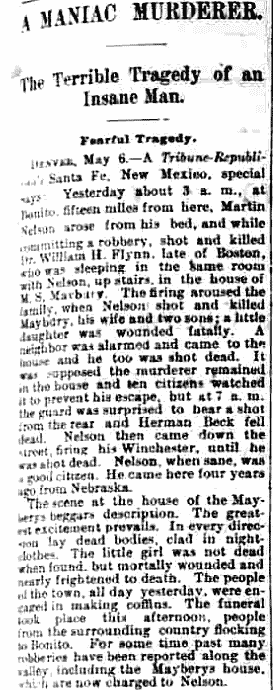 The “ghost story” of Bonito City had its roots in 1885. In a nutshell, it was a robbery that went sour.
The “ghost story” of Bonito City had its roots in 1885. In a nutshell, it was a robbery that went sour.
Martin Nelson was like many young men who dreamed about getting rich overnight. He claimed to be a miner, but no one recalls him actually working.
Some said that he’d been in Bonito City for four years. Others claimed he’d drifted into town the night of the murders. The truth is probably somewhere in between, and Nelson seems to have boarded with a couple of families including the Mayberrys.
Soon after Martin Nelson came to town, robberies were reported. No one was sure who was responsible, and the thefts were generally small.
However, at about 3 a.m. on Tuesday morning, May 5th, 1885, the thief – Martin Nelson – made a fatal error. He decided to steal a watch belonging to Dr. R. E. Flynn, who’d recently arrived from Boston and was staying with the Mayberrys.
Dr. Flynn woke up and raised the alarm, bringing the Mayberry family to his room. Panicking, Nelson shot and killed the doctor, and then began shooting the Mayberry family.
John Mayberry, Sr. and his two sons, John Jr. and Eddie (alternately referred to as Robert), died instantly.
At first, Mrs. Mayberry was only wounded. She and her daughter, Nellie (about 14 years old), ran down the stairs of the boarding house, attempting to escape. Nelson shot Mrs. Mayberry a second time, killing her, and the bullet also struck Nellie.
Nellie pleaded for her life, and Nelson agreed not to shoot her, as long as she promised to attend his hanging. She promised, and he let her live.
(In another version of the story, Martin Nelson was secretly engaged to Nellie, and he was stealing the doctor’s watch so the young couple could afford to elope.)
Meanwhile, saloon owner Pete Nelson (no relation to Martin) heard the shots as he was cleaning up for the night. As he entered Mayberry House, Martin Nelson killed him, too.
By then, a large number of people had gathered outside Mayberry House. Nelson was trapped, and remained there until about 7 a.m. when he tried to escape out the back door of the building.
Unfortunately, grocer Herman Beck (reported as Herman Breck in some stories) was waiting for him. Beck was killed instantly by a single shot from Martin Nelson’s rifle.
Martin Nelson got as far as the street when Charlie Berry, a Justice of the Peace, shot and killed the thief.
(Other versions of the story include a posse chasing Nelson to Littleton Canyon, where he was shot. That seems more credible. In 1933, the bodies were dug up and moved to another cemetery when the city was flooded. Those who saw the remains of Martin Nelson said that his green felt hat was still preserved, and it had several bullet holes in it.)
Martin Nelson’s victims were buried in the town’s cemetery, atop a hill. Nelson was buried outside the cemetery, in a flat area near where Bonito Lake is, today.
Nelson’s body was thrown into a rough pine box, face down, and buried with his body pointing to the west. Some said that this was so he’d never rest. Others said that it prevented him from haunting the town.
(The idea that he’d never rest is more likely. In that era, bodies were usually buried facing up, and pointing toward the east so they could rise and join Christ at the Second Coming.)
Bonito City’s Decline
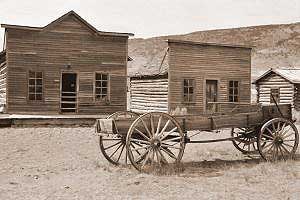 Bonito City’s population boom lasted less than about 20 years. Some miners turned to farming or other work. The majority rushed to find “easy money” in California and elsewhere.
Bonito City’s population boom lasted less than about 20 years. Some miners turned to farming or other work. The majority rushed to find “easy money” in California and elsewhere.
By 1900, Bonito’s ore – what little there was – had played out. The entire population of Lincoln County was just 1,065, and most of them were farmers and merchants building communities in towns like Carrizoza and Runnels. Others worked for the railroad, which brought new people to New Mexico every day.
Bonito’s location was beautiful, but isolated. Some records suggest that just two people lived in Bonito City (sometimes called Bonita City, or just Bonito) by 1910. The town’s post office formally closed in 1911, and by 1920, Bonito City was just a store and seven or eight houses.
In the late 1920s, the Southern Pacific Railroad sought permission to dam Bonito Creek to create a reservoir.
Bonito City was the ideal location for the new lake. Once the railroad negotiated ownership of the land, it hired workers to remove everything that remained of Bonito City.
One Final Journey for Martin Nelson
By 1933, the lake had filled and the water level was approaching the graves of Nelson and his victims.
Members of the Pfingsten family – long-time residents of Bonito City – helped to dig up the bodies for reinterment.
Dr. Flynn’s casket was moved to Texas, where his family lived. The rest of Nelson’s victims were given new caskets and placed in a common grave in Angus, New Mexico, not far from Bonito Lake.
Martin Nelson was also reburied, east of the Angus Cemetery. His body is in a grave at a hill, about 50 feet above the road. The plot is overgrown, but it’s marked with a concrete tombstone.
…
By the 1950s, steam engines were dinosaurs in the railroad world. Bonito Lake was sold and it is now a popular recreational site described in one travel guide as “a fisherman’s paradise.”
If You Visit Bonito City
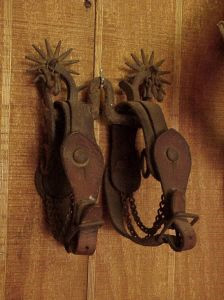 Bonito Lake covers about 60 acres at an elevation of 7300 feet. According to the book, Fly Fishing in Southern New Mexico, it’s “one of the most heavily stocked lakes in the state,” and has “very high use by bait fishermen.”
Bonito Lake covers about 60 acres at an elevation of 7300 feet. According to the book, Fly Fishing in Southern New Mexico, it’s “one of the most heavily stocked lakes in the state,” and has “very high use by bait fishermen.”
The Rockhounds Guide to New Mexico recommends panning for gold along the nearby Rio Bonito. You probably won’t find any gold nuggets, but most New Mexico rivers contain at least some gold dust, and the Bonito is one of the best for that.
If you’re interested in mountain biking, you’ll like Forest Road 107 near Bonito Lake.
Camping is available at the lake from April 1st through November 30th. For more information, or to make reservations, call 575.336.4157.
The lake is open for fishing – but only from the shore – from 6 a.m. to 10 p.m. You can expect to catch rainbow and brook trout, as well as carp.
Remember that swimming, wading, and boating are not allowed in or on the lake.
For additional information about Bonito Lake and vicinity, check your library for books such as 100 Hikes in New Mexico, Frommer’s New Mexico, and New Mexico’s Wilderness Areas.
Ghost Hunting around Bonito City
Bonito Lake is about 12 miles northwest of Ruidoso. Take NM highway 48 north to Angus, and turn left on NM 37. After a mile, turn left again onto Forest Road (FR) 107 (County Rd. C-9). The lake is ahead about three miles.
You can camp at or near the lake; as of late 2009, campsite fees are $14/night, but there are no electrical hookups at campsites. [Link] If you prefer a motel, you’ll find several around Ruidoso and Capitan.
If you watched the Extreme Paranormal episode at Bonito Lake, keep these points in mind:
- Despite what you saw on TV, swimming, boating and wading are not permitted at Bonito Lake. The water is a source of drinking water for nearby communities.
- Never go diving alone in unfamiliar waters. (Though it looked like the investigator was alone, at least one underwater cameraman was probably filming him.) It’s particularly stupid to dive in unfamiliar waters, alone and after dark.
- If you feel as if something might be pulling you underwater, it’s probably a plant, an old fishing line or other debris. Get out of the water. Don’t risk getting further entangled in it. (And always carry a knife to cut yourself loose, if necessary.)
- If you’re on the water and you see lightning, get to shore immediately.
- The floating “circle” of candles looked like a Christmas display in Florida (without Mickey), but it had nothing to do with genuine ghost research.
- Provoking the ghost of a murderer is not a good idea, especially in an isolated location.
The Real Ghosts of Lincoln County
If I was in Lincoln County, New Mexico, these are the potential haunts that I’d research.
- The Bonito City area (not the lake) – Some or all of the town’s land belonged to the Mescalero Indian Reservation. A former resident, Mrs. Pinkie Bourne Skinner, talked about Indians peering into her house. I’d check to see if there had been a Native settlement somewhere near the lake; stolen lands are often very good for paranormal research.
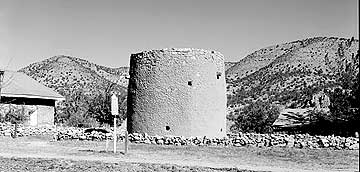 The Lincoln County War – I’d check several sites of drama and tragedy, including: the Torreon (shown at right), Blazer’s Mill (including two cemeteries off Rte. 70) where Billy the Kid was among those involved in the shootout, and the site of the Fritz Ranch, which has additional reasons to be haunted.
The Lincoln County War – I’d check several sites of drama and tragedy, including: the Torreon (shown at right), Blazer’s Mill (including two cemeteries off Rte. 70) where Billy the Kid was among those involved in the shootout, and the site of the Fritz Ranch, which has additional reasons to be haunted.- Fritz Ranch – According to Wikipedia:After Brewer’s death, the Regulators elected McNab as their captain. On April 29, 1878, Sheriff Peppin was directing a posse that included the Jesse Evans Gang and the Seven Rivers Warriors. They engaged in a shootout with the Regulators McNab, Saunders, and Frank Coe at the Fritz Ranch. McNab died in the gunfire, Saunders was badly wounded, and Frank Coe captured.The next day, the Seven Rivers members Tom Green, Charles Marshall, Jim Patterson and John Galvin were killed in Lincoln, and although the Regulators were blamed, this was never proven. Frank Coe escaped custody some time after his capture, allegedly with the assistance of Deputy Sheriff Wallace Olinger, who gave him a pistol.The day after McNab’s death the Regulator known as the “iron clad” took up defensive positions in the town of Lincoln, trading shots with Dolan men as well as US Army cavalry. “Dutch Charley” Kruling, a Dolan man, was wounded by rifle fire by George Coe. By shooting at government troops, the Regulators gained a new set of enemies. On May 15, the Regulators tracked down and captured the Seven Rivers gang member Manuel Segovia, who is believed to have shot McNab. They shot him during an alleged escape. Around the time of Segovia’s death, the Regulator “iron clad” gained a new member, a young Texas cowpoke named Tom O’Folliard.
- Angus Cemetery – Communal graves, such as where Martin Nelson’s victims are buried, are often active. Rootsweb.com has a page listing the most important marked graves and where they are now: Bonito Cemetery webpage. At Angus Cemetery, look for the following murder victims from the Bonito City tragedy: Peter Nelson, Herman Beck, John Mayberry (aged 17 years), Edward Mayberry (aged 7 years), and Mr. & Mrs. W. F. Mayberry. See other graves — marked and unmarked — about two miles below where the dam is. In addition, there’s an extra name on the group headstone: R. F. Oswald. (I’m fairly certain that’s the son of Leo & Alice J. Bragg Oswald, a child who died many years later in Bonita City. His grave was probably moved when the others’ were, but it’s still odd that he’s in the same plot.) And, of course, if I could find Martin Nelson’s grave, I’d check it for EMF, EVP, and so on.(I’m still amazed that the show didn’t include those locations.)
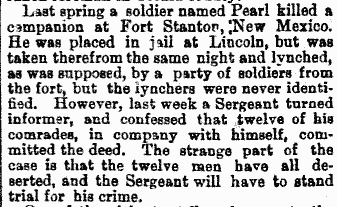 Fort Stanton – This is the Lincoln County site that really interests me. Besides being the first World War II internment camp, the fort — now open to the public — was the site of two lynchings: In the spring of 1883, 13 men lynched a fellow soldier (an alleged gunman). However, according to the newspaper report (at right) just one soldier confessed and stood trial; his 12 accomplices deserted. The lynching of William S. Pearl wasn’t the first at Fort Stanton; on 10 July 1876, outlaw Jose Segura was also lynched at or near the fort. When history seems to repeat itself, that can indicate residual energy. It’s worth investigating.
Fort Stanton – This is the Lincoln County site that really interests me. Besides being the first World War II internment camp, the fort — now open to the public — was the site of two lynchings: In the spring of 1883, 13 men lynched a fellow soldier (an alleged gunman). However, according to the newspaper report (at right) just one soldier confessed and stood trial; his 12 accomplices deserted. The lynching of William S. Pearl wasn’t the first at Fort Stanton; on 10 July 1876, outlaw Jose Segura was also lynched at or near the fort. When history seems to repeat itself, that can indicate residual energy. It’s worth investigating.
It’s always fun to check locations with rumored ghosts. The Martin Nelson story – while not especially unusual – is chilling. In addition, the lake setting presented something unusual for TV.
However, the victims’ graves – and the murderer’s – are just five miles away. Billy the Kid‘s two graves (yes, two of them) are just a daytrip from Bonito Lake. And, since there are numerous other sites of violence and tragedy nearby, there seem to be far richer haunts than one town’s off-limits water supply.
Well… unless you’re filming a really campy, over-the-top TV show, that is. (Note: The guys filming the show in question weren’t responsible for the scripts or editing of the show. In fact, it sounds like a nightmarish experience for them.)
References (in addition to the links in this article)
- Unbelievable – Extreme Paranormal and Bonita City (Also see Extremely Honest: A Conversation with Jason Gowin, published two years after my original article. Similar article was at this link.)
- Pioneer Story: Mrs. Pinkie Bourne Skinner
- Angus Cemetery, Lincoln County, NM (Wayback Machine copy)
- Bonito City – New Mexico Ghost Town
- Killings Began Town’s Slide, by David Bowser / Livestock Weekly
- Mayberry Murder Mystery of Bonita City (Ancestry.com)
- Lincoln County Folktales (link no longer works, but the same story seems to be at Lincoln County Paranormal)
- Myth of the Hanging Tree, by Robert J. Torrez
- The Sacramento Daily Record-Union, 10 Oct 1883
- The Sun, New York, 7 May 1885
- The Salt Lake Daily Herald, 7 May 1885
- The Sacramento Daily Record-Union, 14 May 1885 (clipping shown below)
- Photos include pictures by Lauren Burbank , Keely Dugger, and Loretta Humble.
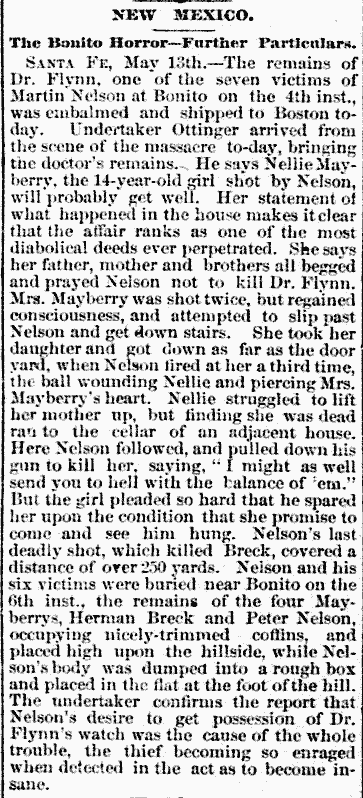

It looks to me like the TV show was only interested in making the story sensational to get a good TV episode. Since the real story wasn’t “spooky”, they embellished it to create the possibility of a haunting. Pffffahh, not just bad TV, but bad journalism. I won’t be watching them any time soon. They have lost the chance to earn my respect.
Vernon,
Thanks for your comment! As a campy, silly show — with only a nod to real ghost hunting — it may be entertaining. With just a few episodes on the air, it’s a little early to tell.
I’m somewhat worried that the absurd “advice” screens will be taken seriously by kids who’ll then emulate what they’ve seen on the show. (I’m talking specifically about “blood rituals” and summoning circles, neither of which are part of serious, scientific investigations.) I’m hoping most children and teens recognize how campy the show is, and laugh at it instead of copying it.
The real Bonito City story sounded grisly as reported in contemporary newspapers… but that’s what they did in the 19th century. Drama sold newspapers, so they turned every possible story into something tragic, gruesome, heart-warming, or redeeming… or all of the above.
I’d never want to trivialize even a single death, but — contrasted with other sites of drama and tragedy — Bonito City was simply where a robbery went horribly wrong.
The town was abandoned by miners as they realized how little gold was there. And, though the Bonito City area is lovely, farmers and merchants generally moved to nearby areas that were more stable and offered more services.
If people want to research cities that were flooded, I think they’ll find juicier stories in other areas. One that comes to mind is the Houston-area reservoir created after the Galveston flood. It’s in the Addicks area, where a town once thrived… until it was swept away by the flood. It’s next to Bear Creek Park (and haunted Patterson Road) where I can personally vouch for several ghost-related phenomena.
(Of course, if the “Extreme Paranormal” guys go there, they’ll probably focus on Blue Light Cemetery. That site involves a particularly grisly story from the 20th century, which I’ve avoided repeating at HollowHill.com. The location is fenced and well-hidden in Bear Creek Park, and very much off-limits to investigations after dark.)
To be fair, Extreme Paranormal isn’t the only show that seems to skip in-depth research. In fact, few TV shows do their homework in that respect.
Then again, they’re TV shows… they’re entertainment, not documentaries. When people confuse the two — and I see this far too often in my email — disappointment is predictable.
Fiona
Miss Broome,
I thoroughly enjoyed your article. I was interviewed on camera for the Bonito City segment on Extreme Paranormal. I ended up on the cutting room floor and I know why.
When I was initially contacted by the show, they were interested in what areas of New Mexico that would be good to shoot in that had a lot of history and paranormal activity. I immediately recommend Lincoln, NM. I told them that I had conducted the first ever paranormal investigation of the Lincoln County Courthouse with Chris Fleming during our shooting of a Dead Famous episode and what were experienced there. I also mentioned other activity that I had witness in other buildings in town. All of this is first hand experience, in addition to the already known history of the town.
They kept asking me about Bonito City and they were, in my opinion, trying very hard to get me to say that the area is very actively haunted. I told them that I knew of NO paranormal activity reports in the area of the lake. They asked me to come down to shoot an interview anyway. (Wasted time and gas that night)
When I arrived, I was introduced to the cast and crew. I was interviewed by Nathan, who is a very nice guy, about the night of the murders. I relayed much of what you have here, although your information is much more detailed, in response to Nathan’s questioning.
The problem came when I was asked about the area being haunted and reported paranormal activity in the Bonito Lake area and I answered truthfully that I was not aware of any reports. The producer didn’t like my answer and wanted me to answer HIS way. I told him that his answer wasn’t factual. This was in addition to other answers of mine that they wanted me to “say a different way”. I did my best to keep my integrity intact and the best way I could.
When I my interview didn’t appear in the show, I wasn’t concerned in the least because after seeing the show, I know why. BTW..Nathan and the other cast members were very nice to me and I would gladly worked with them again in any other show.
Steve Kompier
Steve,
Thanks so much for your comments and insights!
Your experiences with the producer reflect some of mine with other TV shows. Like you, I value my integrity.
Sure, sometimes I’ll phrase things in a way that make people feel better, when it’s appropriate. (For example, if someone really wants to believe that the orb over the kitchen light is a sign from great-auntie Hazel, I’ll agree that it could be.)
Lying isn’t part of that, ever.
The guys did seem very nice, and remarkably patient. I’m not sure that I could go through what they do… not with a straight face, anyway. (Frankly, I think the show needs to make it clearer that it’s just campy fun. My initial reaction to the show wasn’t flattering to anyone on it.)
After I learned that Bonito Lake is technically off-limits to boaters, swimmers and waders, I suddenly understood why one person (during an interview) said he wouldn’t take a boat out on the lake. It’s not that the lake is haunted; it’s that boating is illegal. *chuckle*
This reinforces what many of us say about TV shows: They’re entertainment, and not necessarily produced as factual documentaries. When people confuse the two, they’re often disappointed.
Lincoln County sounds like a great area for ghost research. I barely scratched the surface when I listed nearby places that intrigue me.
However, after seeing how the Extreme Paranormal show was produced and edited, I’m not sure whether to be relieved or sorry that they chose Bonito Lake instead of a site that’s genuinely active.
Thanks again for taking the time to comment. I really appreciate your insights, and I’m especially glad to hear your impressions of Nathan and the cast.
Sincerely,
Fiona
P.S. If you’re the photographer — or are related to him — those pictures are spectacular, and capture textures and contrasts beautifully. I’m always impressed when someone handles b&w well.
Fiona,
I agree with your assessment 100%. Well spoken. If I may ask…in your P.S…which photos are you referring to?
Regards,
Steve Kompier
Steve,
Thanks for the compliments! The photos are at http://www.usefilm.com/photographer/931.html and, if that’s your work, it’s tremendous.
Cheerfully,
Fiona
Fiona,
Yep…those are my photos. Thank you for your VERY flattering words. I’m glad that you enjoyed them.
Steve
Fiona,
I am Nellie Mayberry’s great grand-daughter. All of the stories out there about the Mayberry tragedy are just that: stories. Your story, claiming to be the “real story”, is filled with inaccuracies, because you have basically done the same thing everyone else has done, which is to re-write the tragedy as it is related in all those inaccurate news stories from many years ago.
Nellie was the only eye witness, and she told my Mother what really did happen. And, I am in possession of a hand written letter from the town constable that was written two days after the tragedy that provides details that align well with what Nellie told my Mother.
Yvonne is not my real name, and I will not disclose my name until my story (the REAL real story) is published.
As I said in other forums: Shows like Extreme Paranormal have the very real potential to cause undue pain for the survivors, relatives, and descendants of victims of violent death, and for what? So the average hypnotized and dummied down TV viewer can get their rocks off?
Again, my ancestors have spilled more than enough blood already. That their tragedy is being exploited for sensationalized reality TV is stupid, disrespectful and wrong. I am not much happier about the story being inaccurately portrayed on the internet ghost hunting sites either…
Again, the story has already been told and re-told, and grossly distorted along the way, and
naturally, the ghost story aspect gained steam over time. Just as when anything horrible happens anywhere: ghost stories spring up. This does not make any of these “ghost” stories true!!
And this trend of increasingly disrespectful and aggressive paranormal shows is contributing to fast growing numbers of copycat kids going out there causing property damage at supposedly haunted sites and invading cemeteries all over the U.S.A.
Incidentally, when the “Extreme Paranormal” researchers contacted our family, they were dishonest, hiding the fact that they were out to taunt the killer, “…daring demons to attack” and all that macho childish crap. When I tried to straighten the researchers out on the actual facts, it soon became apparent that the show wasn’t likely to allow the truth to get their way.
I would appreciate it if you’d add a footnote to your story that provides a disclaimer in respect to accuracy, because there’s just no way that you could discern the “real story” from the stuff already written about it. Also, some of your pictures are way off, not of Bonito City at all…
Thank you for your consideration of my position in this saga, Yvonne
Dear “Yvonne Harding”:
Thank you for your comment.
Here’s the short version of what I want to say:
1. You’re using a fake name. That immediately raises questions.
2. You’ve posted this same comment, almost word-for-word, at other websites. That looks dangerously like spam to me.
3. You’re suggesting that my TV-watching readers are “dummies,” and I object to that.
4. You’ve trivialized the extent of my unique research, and the very thorough documentation I posted with this article.
5. You want me to add a disclaimer to my article, based on one 14-year-old’s version of the events, and documents that you claim to have… and no historian has access to.
In summary, if you want to be taken seriously, don’t insult me or my readers. Even more importantly, don’t criticize historical research, with vague references to documents that you are keeping hidden until your book comes out.
You’re trying to sound indignant and moral, saying that your ancestors are being exploited. The bottom line is: You value the expected income and/or fame from your book more, or you’d already have shared this information with the public.
Here’s my full reply to your comments:
My first objection is your pejorative generalization about paranormal enthusiasts — or any of my readers — being “average hypnotized and dummied down TV viewer.” In fact, I think that disparaging comment about TV audiences, in general, is both unkind and inaccurate.
(Even if it was an accurate portrayal, the expression is correctly “dumb [or dumbed] down.” It has been documented to 1933 movie slang, and popularized in today’s culture by John Taylor Gatto’s book, Dumbing Us Down: The Hidden Curriculum of Compulsory Schooling.)
I also considered deleting the phrase that followed in your comment, as it’s vulgar and inappropriate at this website.
Next, I have not just “done the same thing everyone else has done.” In fact, I don’t know anyone else who conducted the extensive historical research that went into this article. That’s shown by my references and the clippings that I obtained (and published here) from the original newspapers… not from anyone else’s website articles, as is routine on many ghost-related websites.
I stand by my research, based on the documents cited in historical records, contemporary with the time of the incidents. When you bring forward proven evidence to show errors in the newspaper reports, I will happily update my article to include corrections.
In fact, I’d urge you to bring forth your evidence as soon as possible. The known and documentable misrepresentations from the TV show prompted me to write this article.
For example, if the show was actually filmed at Bonito Lake — and I’m not sure that it was — they were in a reservoir where boating, etc., are not allowed. That, and several safety issues, concerns me most.
At least one upcoming book will feature Bonito City’s ghost stories. That book may already be in production at the publishing house. It’s by another author (not me), and it will include information from my article. So, it’s imperative that you make your information public as soon as possible, to show your “real” story of Bonito’s past. Otherwise, any errors in the story will be repeated, over & over again.
I routinely hear from people who have books they’ll publish someday… and they never complete their projects. My best advice is: Instead of posting long, contradictory comments at various websites, use that time to write your book and get it published. Then, you can use comments to correct the websites and promote your book at the same time.
If you aren’t able to complete your book in a timely manner, create your own website and place the documented information there.
While I respect your position in this saga, you’re posting with a false name and alluding to evidence that no one has ready access to. I don’t mean to be harsh, but the fact is: Anyone could do that to get attention. It happens every day, online.
Until you come forward with your evidence, those of us who take historical research seriously have nothing to work with except the documented history of that time.
Regarding a disclaimer in respect to accuracy, the same could be said of any article or book. In fact, almost any police officer will tell you that no two witnesses describe the events or the involved people in the same way.
Nellie’s version of the story — which may have influenced how the town constable recorded it — could have been colored by her rumored engagement to the killer, and her eagerness to distance herself from collusion.
In addition, she was 14 years old (according to the newspapers) and had been traumatized by the events as they occurred. Those factors could affect her accuracy. Her version might not be the “real” story, either.
Until we can see the evidence you allude to, we can’t make an informed decision.
Finally, my article is illustrated with photos representing what Bonito City might have looked like. I did not claim that they show the actual city. I wanted to give my readers a sense of what that era was like, and I think those photos provide that, nicely. To the best of my knowledge, there are no good, online, public domain photos from 1885 showing Bonito City. If I’m mistaken, I’d appreciate links to more accurate pictures.
Sincerely,
Fiona Broome
Fiona,
I read through your thoughtful response. You did not deserve to be lumped into the categories of others my family had bad experiences with, as your research does well represent what is available to the public at this time. My regrets.
It is quite a story in of itself, about how we only recently became aware of all the incorrect versions out there. My Mumma, elderly and ailing, found out about the incorrect versions of the story and was very upset, and thus she tasked me to write the real story, to set the record straight. The versions of the story that attempt to link Nellie Mayberry romantically with the killer hurt us deeply.
You also raised good points about my using a phoney name, but I intend to get the real version of Nellie’s story out there soon, and frankly, do not want yet another author jumping ahead of me. I have that right as a direct descendant who possesses the documented facts and inside story unavailable to other historians. I had chosen anonymity to prevent others from doing my family research. I am who I say I am, and have ample pictures and documents to prove it.
In respect to my wanting to gain fame/money from my ancestors’ story: I don’t know what to say to that, except that I am a freelance writer who has to pay the bills like anyone else.
I wanted to respond to your point #5. Please keep in mind that Nellie was the ONLY surviving eye witness to the tragic events in the hotel, and that she herself was shot and in shock. People were devastated, and sought to wrap their brains around what happened. Nellie wasn’t there anymore. A relative quickly came and took her away from Bonito City. Thus the contradicting versions sprang up to fill the gaps and help the townspeople cope. The ghost stories and the idea of Nellie being linked to the killer romantically came many years later…
While I intend to eventually do a book length treatment of the subject, I also agree with you, that timeliness is important, as others continue to write about the story, and with that episode on Extreme Paranormal, there appears to be more interest now. I am sorry that another book is going to recycle incorrect info, but there’s not much I can do about that. I am hard at work on a magazine length feature story, and hopefully we’ll see it out there soon. I am having a bit of trouble discerning what to put in the smaller version of the tragedy, and what to hold back for the book. I have already gone to New Mexico and Bonito Lake to assist my background research process and also, to pay my respects at the Mayberry grave-site.
By copying and pasting some of my comments in several different places, I can see how some may have seen me as a spammer. I am on a deep learning curve with all things internet…and I did become temporarily distracted by all the inaccurate stuff floating about in cyberspace, about what feel to us, like family business. Thus I did not intend to lump all paranormal enthusiasts into the same bag, as I too, am facinated by things unseen and unknowable. The folks at Extreme Paranormal had put a real bad taste in my mouth, with their being self proclaimed “shock jocks of paranormal community” and out to “taunt ghosts and dare demons to attack.” And, they lied to me about their intentions for the show! I feel very very protective.
I spent many hours in the middle of the night alone at Bonito Lake in in the cemetery, and have some things to share, but feel I must do so in the most respectful way possible, and I admittedly have very big concerns about “ghost hunting” in general.
A reader on another forum commented that to provoke the dead is like shoving a stick into a hornets nest, and my guts agree with that statement. That said, I also can see how folks who believe they are experiencing a haunting can benefit from legitimate paranormal people who can help them feel they are putting their “ghosts” at ease. Extreme Paranormal does not fit that bill. The idea of capitalizing on tragedy for entertainment purposes turns me off.
I’ve got a physicist friend who’s fond of saying, “Maybe we know 2% of what there is to know about the universe, and most of that is probably wrong.”
If you would like to email me (you have access to the email address, right?) I could then give you my phone number and we could have a better conversation about all this, and you’ll maybe then see that I am a real (legitimate) person…
I can tell you that they did in fact tape that episode at Bonito Lake, and it is actually quite a hilarious tale in of itself.
Again, thank you for your thoughtful responses and suggestions. I was just initially put of by the title, the “real” story, because that is my intention: to get the real story out there. That said, I do actually appreciate that someone out there made the effort to correct the record, and there’s no way you knew I existed, but that certainly does not reflect any fault in your research!
Be well, happy holidays,
Nellie’s great grand-daughter
P.S. When I get Nellie’s Story out there, I think many people will enjoy reading it, as she was an amazing woman who surmounted much tragedy and went on to live a full and interesting life with much dignity and grace.
Dear Yvonne,
Thanks for your very detailed and thoughtful reply. I definitely appreciate both the content and tone of it.
I’m also very sorry that your family has been forced into the spotlight without adequate preparation for renewed false claims about the Bonito incidents. The sensationalism and absurdity of the Extreme Paranormal episode had to be particularly dismaying.
We can talk later in 2010, when I’ve completed some of my current (and overdue) projects. (I do have your email address.) Like you, writing pays my bills; this website has been one of those proverbial “labors of love” for over a dozen years.
We’re working in a field that’s now attracting self-serving and self-appointed “authorities.” Add the pressures of our challenging (and challenged) economy, and the siren song of small compromises (that lead to greater ones) becomes difficult to resist. I try not to be judgmental when friends (and former friends) make concessions to popularity and income that cost them respect in the paranormal field. Once lost, that respect is nearly impossible to recover.
Integrity and expertise are among our only means to distinguish ourselves from those who use fraud and fiction to achieve short-term goals. Genuine,well-documented research is one of the few ways that we can prove ourselves. However, that documentation can take time… and lots of it.
For over 20 years, I’ve worked as a professional genealogist. Though it’s generally a part-time pursuit now, I specialize in “dead ends” (no pun intended) connected with American families of British and Irish descent. Most of my work is for other professional genealogists.
So, I’m aware of the challenges of the time period you’re documenting, and the time necessary to adequately support single-source stories and historical references. It can be daunting, at best.
When your book is ready, let me know. If I can provide a cover blurb, I’ll be happy to. I’ll definitely link to your book, so that people can read the full story.
Sincerely,
Fiona
@chiren I don’t think you get the point of this
Bugatti, I think you intended to reply at another post or website…?
These are 3 bumbling fools that don’t know squat about ghost hunting.They always contend that they made contact.The stupid occultist fool does not know bull about the occult.In the Bonito case stupid made a pentagram circle and said god will protect them.In a pentagram?Then one sees a shadow , then claims it was a man or woman.How can you tell gender from a shadow?I like TAPS because they go in trying to debunk and don’t go running around,”I saw a shadow”.Stupid shines the light to the window and says,”I saw a man in the window “,then all scramble upstairs find the door locked and says “It was a ghost”.First of all he did not try be logical about it .Maybe it was a curtain,dust,trick of the eye.Television will let any moron with a camera,recorder and so called occultist do a show,oh i forgot its all about ratings not truth.
Andrew,
Thanks for your comments, and I nodded in agreement as I read it.
The good news is, the show was not renewed.
I hate to cheer when I see ratings drop on shows like this, because I feel mean-spirited (no pun intended) when I do that, but… really, I’m looking forward to the time when this field is about research & discovery, and when sensationalism stops being used to attract viewers.
Thanks for commenting!
Sincerely,
Fiona
I am related to The Reverend John Henry Skinner and Pinkie Alice Bourne-Skinner. They are my Great Grand Aunt and Uncle. I have some information from the story told Many years ago, Floy Skinner related the incident of the Mayberry Murder Mystery in Bonita City to A. L. Burke. Floy’s parents, Rev. and Mrs. John Henry Skinner were surviving witnesses as they were among those living in Bonita at the time. In 1885, Bonita City was a sleepy little mining town, composed of log cabins, a saloon, a store, post office, and an enlarged adobe house that served as a hotel. It was owned by Mr. and Mrs. John Mayberry. The Mayberry’s children were Johnny, 17, Eddy, 7, and grown daughter, Nellie. Temporary residents at the time were Martin Nelson, age 24, Dr. R. E. Flynn, and Pete Nelson. In the early morning of May 5, 1885, Martin Nelson went on a shooting rampage, killing Johnny, Eddie, the Mayberry’s and Dr. Flynn. Pete Nelson and Herman Beck, the grocery owner, were also slain as they came running to investigate.
The siege finally ended as Nelson was walking down the street. He was gunned down by Charlie Berry who was conversing with Randolph Schultz and Don Campbell out in the main street. Seven persons had lost their lives. Only Nellie Mayberry survived, and she left Bonita City and was never heard from again. The bodies were laid out in Pete Nelson’s saloon. Rev. Skinner sent Rich Reeves and Robert Bourne for Sheriff John W. Poe who owned the VV Ranch. The deputy, Brent, and Thomas Henley arrived at the saloon late the next day. The bodies were buried side by side, and the body of the killer a reasonable distance away. Fear and shock remained for several years with the folks of Bonita.
After a time, all that was left of the memory was the old hotel. It stood vacant for 15 years before anyone entered its doors. Many believed it to be haunted and claimed strange happenings took place there. When Bonita Dam was built by the Southern Pacific Railroad, the remains of the victims were moved to Angus Cemetery. A large stone marks their resting place.
Old Bonita has become a memory, but the mystery remains. No one knows the reason behind Martin Nelson’s rampage. He made friends, was young, and had no enemies. He was known to have a peaceful disposition. According to Burke and Skinner, “We realize to what extent the people of Bonita must have suffered, and the heroic manner in which they recovered from the shock. We draw the curtain on the Mayberry murder mystery and leave it with the reader.” Source: The Mayberry Murder Mystery of Bonita City, but A. L. Burke. Floy W. Skinner, Copyright Owner, Nogal, New Mexico. Alamogordo News, Alamogordo, NM. Contributed by Janelle Skinner Foster.
Here is From Pinkie Skinner herself: The Lincoln County War had not been over very long and Billy the Kid had been killed only about three months before. We went through Fort Stanton, which was a military post in those days, passed by the old Brewery, which was between Fort Stanton and Angus, and on to a mining settlement which was later called Bonito City. I was so glad to get to where my mother and father were. When we landed on the Bonito Mr. Skinner had only thirty-five cents in his pocket and that was every cent we had. The {Begin page no. 5}first job he got after arriving there was hauling some supplies for some miners. The miners had gone to White Oaks for supplies with a burro team and on the way back the burros got away from them and they were left a foot so they came for Mr. Skinner to haul their supplies about ten miles and they gave him five dollars. We thought that was a lot of money for a little work.
There was plenty of work in the mines and lots of miners coming in every day. It soon grew to be a big camp and they named it Bonito City. we got our mail at White Oaks, New Mexico, about once a month. Later on we got our mail at Fort Stanton and got it oftener. One of the miners would ride horse back to the Fort and get the mail for the whole camp. My mother, one other woman, (I have forgotten her name) and myself were the only women in camp the first winter we were there. Just before Christmas in 1881, father, my two brothers and Mr. Skinner went hunting and killed fifteen wild turkeys and took them to Fort Stanton and sold them for twenty five dollars, we had such a happy Christmas.
We lived in a little old log cabin on the Bonito and it was chinked up with mud. When the mud dried some of it fell out and left holes between the logs. One day while I was cooking dinner I felt some one looking at me through one of these holes, when I went over to investigate, I found several Indians had been peeping through the holes at me. They never did molest anyone around the camp, but we were always afraid of them {Begin page no. 6}for we didn’t know when they would go on the war-path. Soon after landing on the Bonito River we took up a homestead near the camp, proved up on it and got our patent. We lived on this homestead until 1906 when we sold out to the Railroad Company and moved to [Carrisoso?], New Mexico. Mr. Skinner died in [Carrisoso?] in 1925 at the age of 72 years. I am now living with my daughter, Mrs. A.B. [Sumwalt?] at Nogal, New Mexico. I have thirty five grandchildren and thirty eight great grandchildren now living. Counting the in-law and all we have over a hundred members in our family.
NARRATOR: Mrs. Pinkie Bourne Skinner, Nogal, New Mexico, Aged 80.
I’d been wandering around youtube, trying to find good paranormal type shows, when I came across Extreme Paranormal. This show and other shows like it are one of the MANY reasons I no longer believe in occult or paranormal. It definitely gave me a good laugh, though; especially the overly dramatic music and editing.
YumNumz, I’m sorry you’ve stopped believing in the paranormal. I hope you’ll reconsider that opinion, since — despite the silliness of Extreme Paranormal — my research suggests that paranormal events are real.
My search for good paranormal TV shows continues. Even when the teams are credible, the editing by production companies and the demands of networks… well, I understand that they’re trying to create commercially viable entertainment, but — too often — the shows don’t show our research or the investigators in the most authentic or flattering light.
Sincerely,
Fiona
While camping up by Bonito, I recall walking up a hill a bit from our campsite and finding what I believe was a grave that was enclosed with a small fence. I still remember it to this day and always wonder who it was. I was little at the time, but it was not very long ago.
Kristina, if you ever return to that location, let me know what you discover. That’s intriguing.